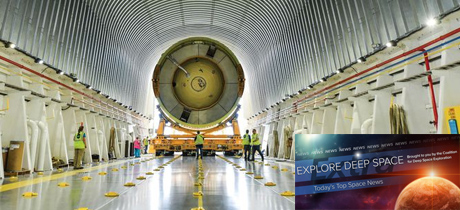In Today’s Deep Space Extra… Christina Koch continues to break the glass ceiling for women, 250 miles up. A dedicated workforce addresses challenges developing the Space Launch System (SLS) heavy lift rocket day by day.
Human Space Exploration
A critical test for NASA’s monster rocket
Coalition Member in the News – Boeing
Air and Space Magazine (February 2020): Nothing is simple when it comes to NASA’s Space Launch System (SLS), the most powerful rocket ever developed. Now at NASA’s Stennis Space Center in Mississippi, the rocket’s first 212 foot long core stage is to undergo a full duration ground test firing this year, paving the way for the launch of Artemis 1, a test flight that will send an uncrewed Orion capsule on a multi week test flight around the Moon and back to Earth. Artemis 2 is to follow with an astronaut crew on board. Artemis 3, which is to launch before the end of 2024 is to return human explorers to the surface of the Moon.
NASA astronaut Christina Koch celebrates her 300th day in space
Space.com (1/16): NASA astronaut Christina Koch, who launched to the International Space Station (ISS) on March 14, 2019, marked her 300th day in space this week, a record for women that is expected to rise to 328 days by February 6, when she is scheduled to return to Earth with two other crew mates. Koch is also in the midst of two spacewalks with fellow NASA astronaut Jessica Meir, one last Wednesday and the second this coming Monday, to complete an upgrade to the Space Station’s solar power storage batteries.
SpaceX will destroy one of its rockets in the pursuit of safety this weekend
The Verge (1/16): The inflight abort test of SpaceX’s Crew Dragon is set for launch Saturday morning from NASA’s Kennedy Space Center in Florida. A four hour launch window opens at 8 a.m., EST. The brief uncrewed flight test to assess the capsule’s ability to escape a catastrophic Falcon 9 rocket failure and descend to Earth intact under parachutes represents a significant milestone in the company’s effort to achieve certification under NASA’s Commercial Crew Program. Certification will lead to the regular transportation of astronauts to and from the International Space Station. Boeing’s CST-100 Starliner is also nearing certification. Saturday’s flight test will air on NASA TV and stream on www.nasa.gov/nasalive.
Space Science
Meteorite or volcano? New clues to the dinosaurs’ demise
New York Times (1/16): The Earth experienced a catastrophic event 66 million years ago, one credited with the extinction of the dinosaurs and much of the life across the planet. Scientists have debated whether it was a giant meteor impact in the Gulf of Mexico or violent volcanism on the Indian subcontinent. New research published in the journal Science suggests it was the Chicxulub impact, though both events significant altered the Earth’s climate.
Op Eds
Column: Ohio will help U.S. get back to the Moon and beyond
Columbia Dispatch of Ohio (1/15): Marla Pérez-Davis, the acting director of NASA’s Glenn Research Center, near Cleveland, Ohio, examines the state’s long history of people and activities supporting human space exploration. The Moon is an essential part of preparing for the human exploration of Mars, she explains.
Other News
Space startups warming to U.S. government as investor, customer
SpaceNews.com (1/16): Space startups and the U.S. government looked to each other more and more in 2019 as significant partners. The creation of the U.S. Space Force and an increase in National Reconnaissance Office (NRO) study contracts were significant factors in the trend, Carissa Christensen, CEO of analyst firm Bryce Space & Technology, told a recent Washington Space Business round table. Moving on to traditional government contracts, however, could prove challenging for new companies, according to industry veterans.
The FCC’s approval of SpaceX’s Starlink mega constellation may have been unlawful
Scientific American (1/16): A research paper due for publication in the Vanderbilt Journal of Entertainment and Technology Law argues the FCC has the authority to regulate the proposed launches of large numbers of small communications satellites into constellations that threaten to disrupt the view of ground based observatories used by professional astronomers as well as casual sky gazing enjoyed by the general public.
Ariane 5 rocket launches communications satellites for India, Eutelsat into orbit
Space.com (1/16): An Ariane 5 rocket successfully launched Thursday from French Guiana placed two European and Indian communications satellites in to orbit.

